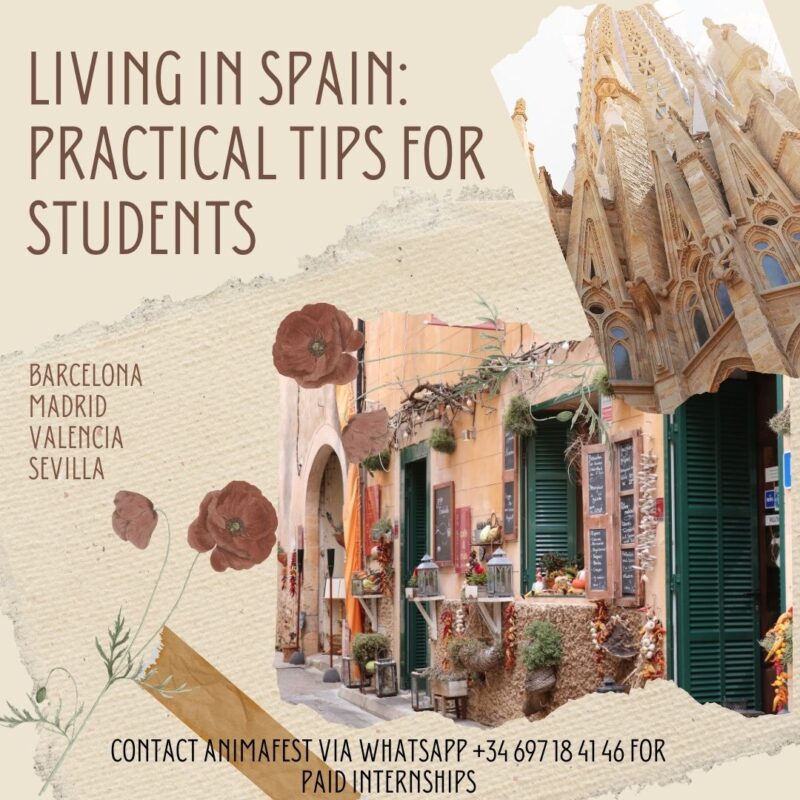Spain is one of the most popular destinations for international students. With its vibrant culture, warm climate, fascinating history and renowned universities, the country offers a unique educational and living experience. However, moving to a new country can be challenging, and it is important to be prepared to make the most of this experience. Here are some practical tips that can help students adapt to their new life in Spain and make the most of it.
If you are looking for a paid internship in Spain, you are in the right place. Animafest Experience offers you this opportunity and all you have to do to get started is sign up here.

1. Find Suitable Accommodation
One of the first steps when arriving in Spain is to find a place to live. Accommodation varies from city to city, but there are options for all budgets. In big cities like Madrid and Barcelona, rent can be expensive, so many students opt to share an apartment, which reduces costs and allows them to meet new people. There are online platforms such as Idealista, Fotocasa and Badi that facilitate the search for rooms and shared apartments.
In addition, some universities offer student residences, which can be an excellent option for those looking for a safe and comfortable environment. In the case of opting for a university residence, it is advisable to apply in advance, as spaces tend to fill up quickly. It is also important to verify the location of the housing and its proximity to the campus and public transportation to facilitate travel.
2. Familiarize yourself with the public transportation system.
Spain has a very efficient and accessible public transportation system, especially in large cities. Most students do not need a car, as the metro, buses and trains work well and connect all corners of the cities. In cities such as Madrid and Barcelona, there are monthly student passes (known as abonos de transporte) that allow unlimited travel for a reduced fare. These passes are ideal for those who plan to travel frequently and want to save on transportation.
In addition, for intercity travel, the country has a network of high-speed trains (AVE) that connects several major cities. For those who plan to travel during their stay, this is a fast and comfortable option. There are also low-cost bus companies such as ALSA, which offer routes to different cities, being an economical alternative to explore Spain.
3. Take Advantage of Inexpensive Food Options
Spanish cuisine is world famous, and living in Spain allows you to try authentic local dishes such as paella, tapas and tortilla española. However, eating out can often be expensive. Many students choose to shop at inexpensive supermarkets such as Mercadona, DIA or Lidl, where they can find quality products at affordable prices.
It is also useful to know that, in most bars and restaurants, tapas accompany drinks, and sometimes they are free, as is the case in cities such as Granada. In addition, universities often have student canteens with affordable menus, and in some cities there are social canteens for students, where food is offered at reduced prices or sometimes free of charge. Preparing meals at home and taking advantage of local markets is a great way to save money and enjoy fresh, local produce.
4. Adapt your Budget and Know the Cost of Living
The cost of living in Spain varies depending on the city. Madrid and Barcelona tend to be more expensive compared to smaller cities such as Valencia, Seville or Granada. It is important for students to prepare a monthly budget that includes housing, food, transportation, leisure and other personal expenses. This will help them to better manage their finances and avoid unnecessary expenses.
In addition, many students are able to work part-time in Spain, although it is important to check visa regulations, as international students must meet certain requirements and hour limits to work. Some common jobs for students include working in cafeterias, stores or as language teachers, especially if they are fluent in English or another foreign language.

5. Take advantage of cultural and leisure opportunities.
Spain is a country full of life and culture, and each city has its own festivals, events and traditions. Students can take advantage of discounts at museums, theaters and other cultural attractions with a student ID card, which often allows free or reduced admission to various venues. In addition, many cities have annual festivals worth visiting, such as Las Fallas in Valencia, the Feria de Abril in Seville or Semana Santa in several cities in Andalusia.
Also, universities often organize activities, excursions and workshops for international students, which is a great opportunity to meet people from other countries and form friendships. There are also language exchanges where students can practice Spanish and, in turn, help others learn their own language.
6. Familiarize yourself with the local culture and norms.
Living in Spain involves adapting to a new lifestyle and certain cultural norms. For example, meal times in Spain are different: lunch is usually between 2 and 3 pm, while dinner is around 9 or 10 pm. Adapting to these schedules can take time, but it is part of the experience of living like a local.
It is also useful to learn some Spanish phrases for everyday life, as although many Spaniards speak English, it is common in less touristy places to prefer Spanish. This facilitates integration and enhances the cultural experience.

Conclusion
Studying and living in Spain is a unique experience that allows international students to develop both academically and personally. From finding accommodation to adapting to the local culture and lifestyle, these practical tips can help make the transition easier and more enriching. With an open mind and a willingness to explore all that Spain has to offer, students can make the most of this experience, creating memories and skills that will serve them for a lifetime.
If you are interested, it’s simple:
1) Create an account on our website https://www.animafestexperience.com/signin.php.
2) Send us a message by WhatsApp +34 697 184 146.
If you have any questions about how to process the documentation, do not hesitate to contact us.







